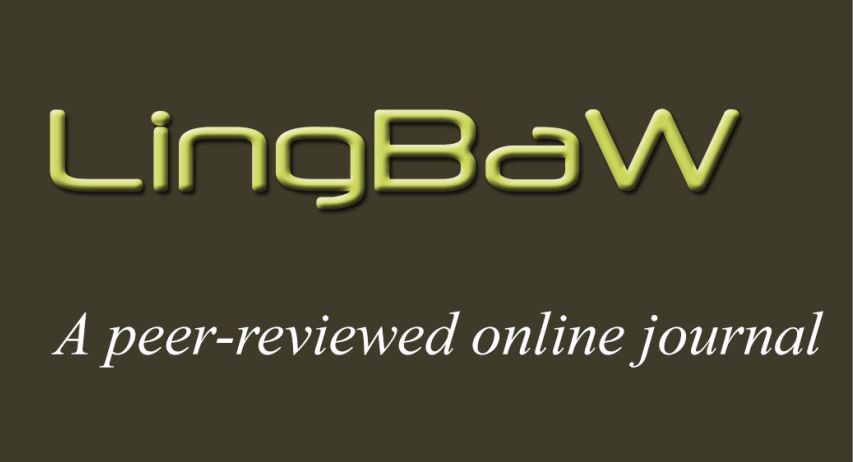What lies beyond and within humour: A relevance-theoretic approach to propositional meanings in the sitcom Modern Family
Abstract
Advancing the proposal that conversationalists frequently engage in humorous communication to convey propositional meanings, the paper aims to employ pragmatic inferential mechanisms specified in a relevance-theoretic framework in order to explicate the viewer’s recovery of additional cognitive effects in sitcom discourse. On this observation, it is assumed that processing of humorous utterances may result in the recipient’s being amused and/ or in making more insightful observations concerning goals a speaker wishes to attain. For example, an interactant would like to communicate a potentially impolite meaning, which is mitigated by means of humour. The corpus is drawn from the American situation comedy Modern Family (2009-2020), created by Steven Levitan and Christopher Lloyd. The focus in the paper is on how the viewer can grasp meanings that are (un)intentionally communicated by the production crew while s/he is sitting comfortably in the armchair. The main thrust of the present paper is twofold. First, extra cognitive effects can be best described in terms of propositional meanings they communicate, which in turn necessitates a relevance-theoretic notion of weak communication. Second, I postulate that accessing humorous effects is just the first step in order to fully understand a conversational episode in the sitcom, granted that viewers may be eager to spend more processing effort in exchange for extra cognitive rewards. It is frequently the case that the recipient’s mental representations are strengthened or challenged by the production crew’s (cultural) representations. More specifically, it will be demonstrated that the functions of conveying and/ or challenging of social norms, disclosing character-specific information and providing cultural references aim to strengthen or challenge the viewer’s personal beliefs.
Keywords:
relevance theory, humour, sitcom, propositional meaning, weak communicationReferences
Bell, A. 1984. Language style as audience design. Language in Society 13(2): 145–204. https://doi.org/10.1017/S004740450001037X (Crossref)
Brock, A. 2011. Bumcivillian: Systematic aspects of humorous communication in comedies. In R. Piazza, M. Bednarek, and F. Rossi (eds.), Telecinematic discourse: Approaches to the language of films and television series, 263–280. John Benjamins Publishing Company. (Crossref)
Brock, A. 2015. Participation frameworks and participation in televised sitcom, candid camera and stand-up comedy. In M. Dynel, and J. Chovanec (eds.), Participation in public and social media interactions, 27–47. John Benjamins Publishing Company. (Crossref)
Bubel, C. 2008. Film audiences as overhearers. Journal of Pragmatics 40(1): 55–71. https://doi.org/10.1016/j.pragma.2007.10.001 (Crossref)
Clark, H. H. 1996. Using language. Cambridge University Press.
Clark, H. H., and T. B. Carlson. 1992. Hearers and speech acts. In H. H. Clark (ed.), Arenas of language use, 205–247. The University of Chicago Press & Center for the Study of Language and Information.
Clark, H. H., and E. F. Schaefer. 1992. Dealing with overhearers. In H. H. Clark (ed.), Arenas of language use, 248–273. The University of Chicago Press & Center for the Study of Language and Information.
Coates, J. 2007. Talk in a play frame: More on laughter and intimacy. Journal of Pragmatics 39(1): 29–49. https://doi.org/10.1016/j.pragma.2006.05.003 (Crossref)
Dynel, M. 2011. ”I’ll be there for you!” On participation-based sitcom humour. In M. Dynel (ed.), The pragmatics of humour across discourse domains, 311–333. John Benjamins Publishing Company. (Crossref)
Hay, J. 2000. Functions of humor in the conversations of men and women. Journal of Pragmatics 32(6): 709–742. https://doi.org/10.1016/S0378-2166(99)00069-7 (Crossref)
Holmes, J. 2000. Politeness, power and provocation: How humour functions in the workplace. Discourse Studies 2(2): 159–185. https://doi.org/10.1177/146144560000200200 (Crossref)
Holmes, J. 2006. Sharing a laugh: Pragmatic aspects of humor and gender in the workplace. Journal of Pragmatics 38(1): 26–50. https://doi.org/10.1016/j.pragma.2005.06.007 (Crossref)
Holmes, J., and M. Marra. 2002a. Over the edge? Subversive humor between colleagues and friends. Humor 15(1): 65–87. https://doi.org/10.1515/humr.2002.006 (Crossref)
Holmes, J., and M. Marra. 2002b. Having a laugh at work: How humour contributes to workplace culture. Journal of Pragmatics 34(12): 1683–1710. https://doi.org/10.1016/S0378-2166(02)00032-2 (Crossref)
Jodłowiec, M. 1991. What makes jokes tick. UCL Working Papers in Linguistics 3: 241-253.
Jodłowiec, M. 2008. What’s in the punchline? In E. Wałaszewska, M. Kisielewska-Krysiuk, A. Korzeniowska, and M. Grzegorzewska (eds.), Relevant worlds: Current perspectives on language, translation and relevance theory, 67–86. Cambridge Scholars Publishing.
Kuipers, G. 2006 [2015]. Good humor, bad taste: A sociology of the joke. Mouton de Gruyter. (Crossref)
Kuipers, G. 2008. The sociology of humor. In V. Raskin (ed.), The primer of humor research, 361–398. Mouton de Gruyter. (Crossref)
Martin, R. A. 2007. The psychology of humor: An integrative approach. Elsevier Academic Press.
McKeown, G. 2017. Humor as an ostensive challenge that displays mind-reading ability. In N. Streitz, and P. Markopoulos (eds.), Distributed, ambient and pervasive interactions, 627–639. Springer. (Crossref)
Messerli, T. C. 2017. Sitcom humour as ventriloquism. Lingua 197: 16–33. https://doi.org/10.1016/j.lingua.2017.05.006 (Crossref)
Meyer, J. C. 2000. Humor as a double-edged sword: Four functions of humor in communication. Communication Theory 10(3): 310–331. https://doi.org/10.1111/j.1468-2885.2000.tb00194.x (Crossref)
Mills, B. 2009. The sitcom. Edinburgh University Press. (Crossref)
Norrick, N. 1993. Conversational joking: Humor in everyday talk. Indiana University Press.
Palmer, J. 1994. Taking humour seriously. Routledge.
Piskorska, A. 2016. Po co rozmawiamy? O funkcjach komunikacji w ujęciu teorii relewancji. Tertium.
Piskorska, A., and M. Jodłowiec. 2018. Weak communication, joke targets and the punch-line effect: A relevance-theoretic account. Studies in Polish Linguistics 13(1): 25–44. https://doi.org/10.4467/23005920SPL.18.002.8464 (Crossref)
Rossi, F. 2011. Discourse analysis of film dialogues: Italian comedy between linguistic realism and pragmatic non-realism. In R. Piazza, M. Bednarek, and F. Rossi (eds.), Telecinematic discourse: Approaches to the language of films and television series, 21–46. John Benjamins Publishing Company. (Crossref)
Schnurr, S., and B. Plester. 2017. Functionalist discourse analysis of humor. In S. Attardo (ed.), The Routledge handbook of language and humor, 309–321. Routledge. (Crossref)
Solska, A. 2012. The relevance-based model of context in processing puns. Research in Language 10(4): 387–404. (Crossref)
Solska, A. 2023. The interpretative non-prototypicality of puns as a factor in the emergence of humor and in phatic communication. Intercultural Pragmatics 20(2): 133–159. (Crossref)
Sperber, D., and D. Wilson. 1986 [1995]. Relevance: Communication and cognition. Blackwell.
Sperber, D., and D. Wilson. 2002. Pragmatics, modularity and mind-reading. Mind & Language 17(1–2): 3–23. (Crossref)
Suls, J. M. 1972. A two-stage model for the appreciation of jokes and cartoons: An information-processing analysis. In J. H. Goldstein, and P. E. McGhee (eds.), The psychology of humor: Theoretical perspectives and empirical issues, 81–100. Academic Press. (Crossref)
Wieczorek, M. 2019. Humour in Relevance Theory: A pragmatic analysis of jokes. Scientific Publishing House of Siedlce University of Natural Sciences and Humanities.
Wieczorek, M. 2021. Humour as a carrier of meaning in sitcom discourse: a data-based study from a relevance-theoretic perspective. Unpublished dissertation. University of Warsaw.
Wilson, D., and R. Carston. 2007. A unitary approach to lexical pragmatics: Relevance, inference and ad hoc concepts. In N. Burton-Roberts (ed.), Pragmatics, 230–259. Palgrave-Macmillan. (Crossref)
Wilson, D., and D. Sperber. 2002. Truthfulness and relevance. Mind 111(443): 583–632. http://www.jstor.org/stable/3093623 (Crossref)
Wilson, D., and D. Sperber. 2004. Relevance Theory. In L. R. Horn, and G. Ward (eds.), The handbook of pragmatics, 607–632. Blackwell.
Yus, F. 1998. Relevance theory and media discourse: A verbal-visual model of communication. Poetics 25(5), 293–309. https://doi.org/10.1016/S0304-422X(97)00020-X (Crossref)
Yus, F. 2002. Stand-up comedy and cultural spread: The case of sex roles. Babel A.F.I.A.L. 11: 245–292.
Yus, F. 2003. Humor and the search for relevance. Journal of Pragmatics 35(9): 1295–1331. https://doi.org/10.1016/S0378-2166(02)00179-0 (Crossref)
Yus, F. 2005. Dave Allen’s stand-up monologues: An epidemiological approach. In J. Mateo, and F. Yus (eds.), Thistles. A homage to Brian Hughes. Volume 2: Essays in Memoriam, 317–344. University of Alicante.
Yus, F. 2016. Humour and relevance. John Benjamins Publishing Company. (Crossref)
Yus, F. 2017. Relevance-theoretic treatments of humor. In S. Attardo (ed.), The Routledge handbook of language and humor, 189–203. Routledge. (Crossref)
Ziv, A. 1984. Personality and sense of humor. Springer.
Ziv, A. 2009. The social function of humor in interpersonal relationships. Society 47(1): 11–18. https://doi.org/10.1007/s12115-009-9283-9 (Crossref)
University of Siedlce https://orcid.org/0000-0003-3701-2884







